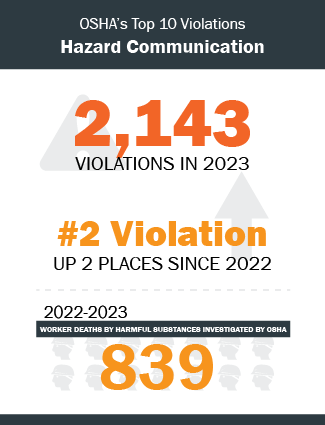GHS-Compliance: Safe and Effective Storage of Hazardous Chemicals

The Importance of the GHS
Adhering to GHS Guidelines for Safety and Proper Chemical Storage
The explosion that killed a natural gas pipeline installer along a busy Alabama freeway could be heard and felt for miles. An investigation conducted by the Occupational Safety and Health Administration (OSHA) concluded that the explosion was caused by the improper storage of flammable welding gases. The chemicals ignited from the lack of ventilation when the employee opened the door. This tragic incident underscores the importance of adhering to GHS guidelines and GHS labeling requirements for the safe handling and storage of hazardous chemicals.
"Employers who use hazardous chemicals in their workplaces are required to train employees on chemical safety data sheets and labels, and incorporate safety controls to protect employees from those hazards," said OSHA officer Ramona Morris. "This tragedy could have been avoided if the employer had followed required procedures for storing dangerous gases."
OSHA Violations Increasing: HazCom and GHS Compliance
OSHA's rules on proper storage of welding gases, as well as employee training, can be found in 29 CFR Part 1910 Subpart H. Additionally, chemical labeling and signage, including OSHA chemical labels, is a key part of OSHA's HazCom 2012 regulations. Data over the past few years show that violations involving hazard communication are increasing. The top 3 most cited OSHA violations for 2022 are:
- Fall Protection: 5,260 violations.
- Hazard Communication: 2,424 violations.
- Respiratory Protection: 2,185 violations.
HazCom violations have been holding second place for most violated standards for several years now, and the amount of hazard violations has risen 5 percent since 2021.
The Chemical Safety Board assists OSHA in educating facilities on safety best practices for hazardous materials and chemical handling.
"Over the past decade of investigating chemical incidents, the CSB has found that effective emergency response training and planning, as well as communication between the company, emergency responders, and the community, are critical to preventing injuries and fatalities from chemical incidents," the agency said in its October report.
Take Precautions Following GHS Protocols

Unsafe chemical storage causes injuries and deaths, not only for workers but also for members of the public and responding emergency crews. Storing materials properly with the right OSHA labeling will help to limit chemical hazards; however, it does not eliminate them. While location and set up of hazardous materials are important, here are four precautionary tips to keep workplaces safer:
- Identify the hazard: Check the chemical's label, including GHS compliant labels, and pay attention to its properties and characteristics. Some materials can cause health problems, ranging from headaches to cancer, while others can be dangerously flammable or explosive.
- Maintain communication: Use safety data sheets to keep track of the detailed information about each chemical. Check both the GHS labels and the SDS before working with chemicals and storing them.
- Prepare for an emergency: Effective planning and preventive actions can minimize losses. Have emergency and clean-up stations stocked, identified, and ready to go if needed.
- Gear up: Help workers understand what personal protective equipment to use for various substances and situations. PPE needs to be matched to the hazards that are present, and it should always be used as the last line of defense after other controls are in place.
It is important to maintain a high level of safety when both working with and storing chemicals and other hazardous materials. Be aware of the potential hazards chemicals can pose to workers. Chemical accidents can cause havoc across the workplace and even in surrounding neighborhoods. Perform a job hazard analysis (JHA) to identify chemicals and equipment that could cause a spark or other reaction.
- Use safer materials and equipment when possible.
- Examine housekeeping policies and keep workplaces neat and clean.
- Inspect containers and chemical storage areas for corrosion, wear, and damage that could be a potential hazard.
- Ensure all safety signs and GHS chemical labels are correct and maintained for clarity.
- Train workers on hazardous substances using up-to-date videos, infographics, safety tips, and more that support a strong HazCom program.
Visual Safety Communication Resources from DuraLabel
Visual communication plays a role in the safety of employees. Knowing where common hazards occur in your facilities or in the field can help your team navigate their workspace safely and more efficiently. DuraLabel’s free OSHA Safety Signs Instant Action Guide helps you create safety signs that meet OSHA labeling requirements. The free guide helps readers understand the appropriate regulations and standards and improve safety and efficiency. Request your free OSHA Safety Signs Best Practice Guide
You can trust the Toro Max and Kodiak Max printers to handle all of your safety signs and labeling needs. Request your free OSHA Safety Signs Best Practice Guide
Whether you need safety signs, pipe markers, or equipment labels — Toro Max and Kodiak Max are ready to transport anywhere you are. Get help crafting a system that will provide the safety communication you need. Call 1-888-897-5580 and one of our experts will guide you through the process.
Learn more about hazard communication and safety compliance.
Read Next:
Related Resources

What is HAZOP? HAZOP Analysis and Industrial Label Printer Insights
Workplace safety should always be at the forefront of your mind. Many recommendations exist on how to go ...
Read
What is HazCom? Your Guide to Chemical Labeling, GHS, & OSHA Standards
What Is OSHA’s Hazard Communication Standard (HazCom)? "HazCom" is short for "Hazard Communication," OSHA’s ...
Read
OSHA Rules for Hazardous Chemicals
When dealing with hazardous chemicals, safety is key. However, the steps necessary to keep workers safe will ...
Read.png)




